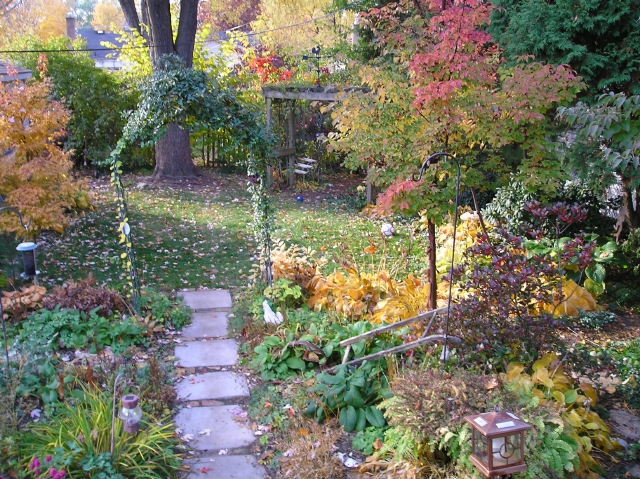Low Impact Gardening


Is it just me, or did we have an unusual fall here in Michigan? Record high temps well into October, not much fall color, leaves staying in the trees well into November. It’s early in November as I write this, and there are still impatiens blooming in a protected area of the yard! I haven’t yet done a thing with the few leaves laying on the lawn and garden, since most of them are still up in the trees. Global warming? Is this how fall will be here in Michigan in the future? What will winter bring?
Last fall I tried something kind of new and low impact, and thought you might like an update on that. My theory was that if I left the sycamore leaves to pile up in the front yard, and merely chopped up the ones on the lawn and left them lay, that there would be no more leaves in the landscape in the spring than any other spring. Well- it seemed to play out that way- theory correct in this instance, so I’ll be doing the same thing this year- that is, if and when those leaves ever come down! Additionally, the lawn did fine, I think I even watered less because of the extra organic matter tucked around the mixed weeds and grasses that are my lawn. Fertilizer was not in my budget, so it had to get all it’s nutrients from the leaves too.
Sometimes I wonder where this practice of removing every leaf from our home landscapes came from. To me it’s contrary to nature- in fall those leaves come down an tuck themselves under the trees and shrubs, blowing into piles and decomposing where they lay, enriching the soil, feeding micro-organisms and small critters, providing shelter, blanketting roots and seeds against extreme weather and temperatures. In spring as they continue to decompose, heat is created, they retain moisture and continue to break down making a wonderful seed bed, and allowing new plants to grow while keeping moisture even. People work so hard to have what they call a pristine landscape- removing the natural leaf mulch entirely, only to put down an un-natural covering of shredded wood or bark, or even small rocks! And to further prevent any wayward plants from volunteering in their planned sterile garden, under that heavy layer of mulch is a non biodegradable plastic fabric to keep that stuff from ever becoming one with the earth. I just shake my head at some of my neighbors blowing every leaf out from around their foundation plantings (can’t possibly be called a garden in my opinion) to create that sterile look for the winter. I feel so sorry for their 50 year old meatball yews.
Another thing that doesn’t happen if you keep a sterile landscape like that is you don’t get interesting volunteers that blow in, or are pooped in by birds and small animals. In any season I can find something new that I didn’t plant (yes, some of them are weeds, those get yanked out) that I allow to stay for a while until I decide if I should keep it or not. Right now there are maturing trees that I know just seeded into my garden, I recognized them as being something I might like to have, and allowed them to grow. One of them is a native white Dogwood, planted in the light shade of a red maple- large white flowers, great fall color. The other is a Pagoda Dogwood- interesting branch stucture, clusters of fragrant white flowers, berries for the birds, and great fall color. This year it looks like I may have a small privet bush that started in a planter box- I may or may not keep it, but it sure does have some nice shiny deep green leaves. I also found a tiny deep red Japanese maple seedling in one of my client’s gardens- nurtured over the summer, it’s tucked into my garden for the winter in a protected spot. Additionally, I know there are all kinds of perennials, bulbs and wildflowers that came here from elsewhere or seeded themselves in, that I would not have if I were a meticulous gardener.
I guess I’ll just continue to garden in my own low impact way, and try to teach by example. I like to see things as God and nature intended, not sterile and contrived the way man tries to re-create things. I’m seeing the beginnings of a movement of some people towards a more organic low impact way of doing things, in our food supplies, stores, household products etc. and I can only cheer. I hope those same people are also ‘going green’ in their own portion of the world, their gardens. We all have a long way to go, but it’s a start.
See you in the garden!




Hello Ellen, I like your blog. Found you through a search for wildlife gardening blogs.Seems we have a similar style. I will be reading some of your archives as there is time.
Do you blog much through the winter?
I try to write at least once a month- I write for my local Master Gardener Newsletter and also post the articles on line on this blog.
I’m starting a new chapter in my life right now, so stay tuned, dramatic changes for me and my gardening life.
I totally agree on your viepoint on Gods Masterplan in Gardening. I like any color in my garden, although of course I have favs, and will sometimes my unmarked things, because I think of a rainbow created by God. My flowers bring me such peace and happiness, I think you understand. Nothing feels so good as soil in your hands! Love your blog! Hope you like Plymouth, it’s a nice town! They us to have a deli there about 20 years ago, I;m thinking Max’s was the name. Boy was that good stuff! Not far off main street, YUM! Angie